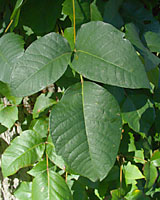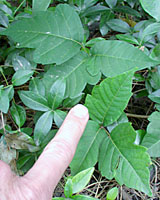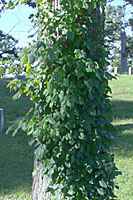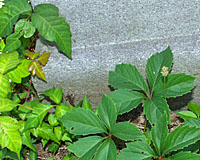Terry L. Ettinger Horticulture Consulting Services
Meeting The Needs Of Today With A Vision For The Future
Special Topics
Worst Weeds in Landscape Plantings
Poison Ivy - Rhus radicans
 “Leaves of three, let it be” (at right) was my introduction to the
identification of poison ivy. However, because poison ivy leaves can
look very different at different stages of development (seedlings
versus mature vines, for example) and under different growing
conditions (sprawling groundcover, below left, upright shrub, or clinging vine,
below right), it’s not one hundred percent reliable.
“Leaves of three, let it be” (at right) was my introduction to the
identification of poison ivy. However, because poison ivy leaves can
look very different at different stages of development (seedlings
versus mature vines, for example) and under different growing
conditions (sprawling groundcover, below left, upright shrub, or clinging vine,
below right), it’s not one hundred percent reliable.
 To be sure of its identification, I suggest having a certified arborist or certified nursery professional inspect your
property. They can explain the differences between poison ivy and
the dark green, palmate-leaf of the ornamental vine, Virginia
Creeper, for example. In the center of the picture below, at left,
Virginia Creeper is surrounded by lighter green leaves of poison
ivy.
To be sure of its identification, I suggest having a certified arborist or certified nursery professional inspect your
property. They can explain the differences between poison ivy and
the dark green, palmate-leaf of the ornamental vine, Virginia
Creeper, for example. In the center of the picture below, at left,
Virginia Creeper is surrounded by lighter green leaves of poison
ivy.
Meanwhile, you may find that removing poison ivy completely from your property will be difficult, if not impossible, to accomplish.
 The best time of year to treat poison ivy with non-selective herbicides such as Roundup or Kleenup, or selective “brush”
control herbicides containing triclopyr as the active ingredient applied directly to the leaves is mid-August through mid–
to late September.
The best time of year to treat poison ivy with non-selective herbicides such as Roundup or Kleenup, or selective “brush”
control herbicides containing triclopyr as the active ingredient applied directly to the leaves is mid-August through mid–
to late September.
It’s quite likely, however, that repeat treatments with herbicides over the course of several seasons will be needed to completely kill well-established plants.
 Also, remember that these herbicides will
kill desirable plants just as easily as they will kill the poison ivy that you’re targeting, so be very careful where and
how these materials are applied!
Also, remember that these herbicides will
kill desirable plants just as easily as they will kill the poison ivy that you’re targeting, so be very careful where and
how these materials are applied!
If you’d rather avoid herbicides, your only option will be to keep plants cut back to the ground on a regular basis. Over the course of several growing seasons repeated defoliation of the plants can result in their death. Unfortunately, even if you are successful in controlling the current crop of poison ivy, it can become reestablished from root sprouts emerging from plants on neighboring properties and by seeds in bird droppings!
Finally, please remember that urushiol, the chemical responsible for causing poison ivy rashes, is very persistent on clothes, shoes, tools and even the fur of pets that come into contact with damaged plants. Therefore, wash these items – including your pets - thoroughly if you think there’s a chance they’ve been contaminated! Also, work with your physician and vet to develop a plan for managing potential exposures to urushiol before they occur in the future.